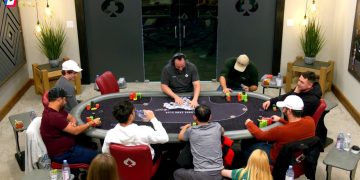Congratulations, you’ve started to play in Texas Hold’em poker tournaments. You feel like you’re up on the poker rules, you understand the basics of Texas Hold’em poker, and you want to start playing against others. This is as good a place as any to perfect your poker strategy, learn chip stack management and learn how to read poker hands, even if you’re going to be paying for the privilege.
Management of Your Chip Stack
Your chip stack is going to play a vital role in your poker strategy going forward and what kind of poker hand you’re willing to play, so it’s a good idea to start getting familiar with what various sizes of stacks mean to you.
Chip stack management requires understanding a few factors. How many chips you have is important, of course, but the size of your chip stack compared to the other people at the table is also very important. You’re also going to start having to deal with the reality of changing blind levels, which should always cause you to re-evaluate where every player at your table really stands.
Pulling things back to basics is going to require you to do some very basic math. When most people look at chip stack size, they’re looking at their stacks in terms of how many big blinds they can play through. Your stack’s size, then, is the number of chips you have divided by the current size of the big blind, rounded down. If you’ve currently got a thousand chips and the big blind is one hundred, you’ve got a 10 big-blind stack.
It’s a good idea to remember that poker tournaments tend to are going to vary in the chip stack with which you’ll start. Little tournaments will typically give you seventy-five to one-hundred-fifty times the big blind, while bigger tournaments might give you up to two hundred times the blind. There are even huge tournaments that will start you off with much bigger amounts, meaning that you’re going to have to consistently change the way you look at your stack.
Understanding Chip Stack Sizes

Sometimes it’s nice to get the basics down. We’re going to look at stack sizes in terms of the categories in which they fall, followed by the way that they are going to influence your play. Importantly, we’re going to take a look at your effective stack size here – not necessarily what you have on hand, but rather what you can realistically win from another player.
Yes, that’s another thing you’re going to have to worry about. Your strategy is going to depend largely on what you can possibly win, so you’re going to be managing your opponent’s stack in your head at the same time as you own. This is another one of those bits of poker strategy that takes time to learn, but that will get you far ahead of virtually everyone else who sits down at your table.
With all of that said, we’re going to take a look at how the various stack sizes are categorized and how they will impact your play style. Given that we’re going to be optimistic, we’re going to start by looking at how you’ll play with a big stack and then work our way down to the worst-case scenarios.
Large Chip Stack – 50 Big Blinds or Better
Congratulations – you can actually focus on your own poker strategy. This is where you are going to start in almost every tournament, so consider this a default mode of play the first time you sit down at the table. You’ll get to use every trick and strategy you’ve ever learned when your stack is this deep, but you should also expect that your opponents can do the same thing.
If there’s a single word that defines this position, it is options. You can do virtually anything here. Want to be incredibly aggressive? Great, you have the chips to back that up. Want to test out the waters and speculate on a mediocre hand? It’s not recommended, but you might as well try now. A single mistake probably isn’t going to force you off the table, so you might as well have a little fun.
What you do need to look at, though, is where the blinds sit. Keep track of time, because your position will suddenly change if the blind goes up. Make your big moves quickly and be prepared to step things down as soon as it gets more expensive to stay in the game, especially if your stack is towards the bottom of this range.
Medium-Large Chip Stack – 40 to 50 Big Blinds
You’re not quite at the top of the hill, but you’re really close. You still have access to most of your usual tricks and strategies, but you’re going to have to get smarter about how you are going to bit. It’s harder to throw away a hand when you’re already committed, but it’s not impossible. In this spot, your ability to read your opponent is going to be more important than ever.
You should really be paying attention to how the other people at the table are playing when you’re in this range. While that’s always a good idea, you’re really going to be probing for weakness here. You’re a more dedicated player at the medium-large range, so figuring out who’s likely to fold when things get hot and who is raising inefficiently is going to have a huge impact on your ability to stay in.
Medium Chip Stack – 30 to 40 Big Blinds

This is where you start to become a more cautious player. You’re going to start to fold more hands, but that’s not a bad thing. Consider this the opening range for playing incredibly smart poker, which is something that’s going to help you win more and more often.
You don’t get to play around with your money here any longer, though. Knowing the odds is a very good idea, and you’re not going to play guessing games any longer. You’re not chasing long shots to be sure, but you are still going to play when things feel favorable – at least, in early positions.
In the late position, you still have a lot of room for aggression. Pay attention to how other players bet, and then go after them when there’s enough blood in the water. You’ve definitely got enough weight behind you to be a bully to weaker players and those who are overly cautious, so use those chips as leverage when you can.
Medium-Short Chip Stack – 20 to 30 Big Blinds
The game gets tight around this point. If you decide that you’re going to raise on a hand, you better be willing to ride it all the way to the bitter end. This is the type of stack where you’re going to go all-in, especially if you’re still in before the flop.
While you stack size is small, you’re going to be incredibly aggressive any time you are in the game. If you re-raise before the flop, you need to throw in at least half of your remaining chips. If you aren’t willing to go this big, you shouldn’t be in the hand at all.
Short Stack – 10 to 20 Big Blinds
You’re in the danger zone now, so you don’t have a lot of room for speculation. Your goal is to increase this pile as quickly as possible so that you can get back in the game. This means playing in a style that feels reckless, but you simply can’t afford to stay here for very long.
Your pre-flop hands only come in two types – you’re either folding or you are all in. If you are playing, you are playing to win, no other options. Again, this isn’t a great stack to have and pushing out of this zone is the only way you are going to stay in a tournament. The money’s worth the fight, so do what you can to ensure that you get what’s yours.
Very Short Stack – 5 to 10 Big Blinds

This is where games fall apart for most player. Folding isn’t even safe any longer, because even big blind (or antes) are going to eat up most of your stack. You have to rebuild, and you have to do it as quickly as possible. No more tricks, no more traps – nothing but pure aggression here.
The only option for betting here is all in. Anything else is going to be too slow to work for you, and in fact most other moves are going to help other players make assumptions about your weakness. You are going to work to bully anyone who will take the bait, and you are going to hope that things work out well enough for you that you can get back in the game.
Critically Short Stack – Under 5 Big Blinds
At this point the alarms are sounding and your ship is sinking. You no longer have any chips to spare, and even being the big blind on a mediocre hand is going to push you out the tournament. Your best friends right now are luck and absolutely recklessness.
Position is everything here. You’re going all in on nothing if you’re either of the blinds. If there’s an ante, you’re going all in on anything that’s playable. Given that you can’t threaten anyone with your awful stack, though, everything’s going to come down to the cards on the table and what your opponents have in their hands.
Final Thoughts
Picking up this poker chip stack management skill automatically elevates you to a new level of play. The vast majority of novices don’t really understand the fine distinctions here – they understand bigger and smaller stacks, but the vast majority of them are not going to base their playing strategies on chip size management. This gives you a huge leg up on most of the competition.
Try to look at your chip stack as just one more part of you arsenal. In many cases, the size of your stack will actually be more important than the cards in your hand, so try to learn how to use them effectively. It’s obvious that you should always want to push for a big chip stack in poker, but understanding all the options that gives you can change your game.
So, what do you do now? You start meticulously keeping track of what’s in front of you, you adjust your strategy and your chip stack grows and shrinks, and you pay more attention as you approach the end of the tournament. Practice makes perfect here, so don’t feel discouraged when you don’t get it right at first. If you keep practicing, you’ll elevate your game and win more often. See you at the WSOP!
♠ pokerjournal.org
Chip Stack Management – FAQ
How many chips are in a starting stack?
If it's a cash game, your starting stack is equivalent to how much money you bought in for. If it's a tournament, you're starting stack will usually be somewhere between 10k and 30k in tournament chips.
How many big blinds should you have in a tournament?
Every tournament is different. To play a comfortable game, around 30-50 BB. Personally, I don't go into auto-shove mode until I'm down to five big blinds. That's still enough to get folds with a pre-flop raise.
What is a big stack poker tournament?
It's usually called a Deepstack tournament. This means you're starting with more chips than usual and the levels are usually longer. The most common deepstack structure is 30k in starting chips and 30-minute levels.
How many poker chips do I need for 10 players?
If there are 10 players and the starting stack is 10k in chips, then you need 100k in chips for all the players at the table.


















Discussion about this post